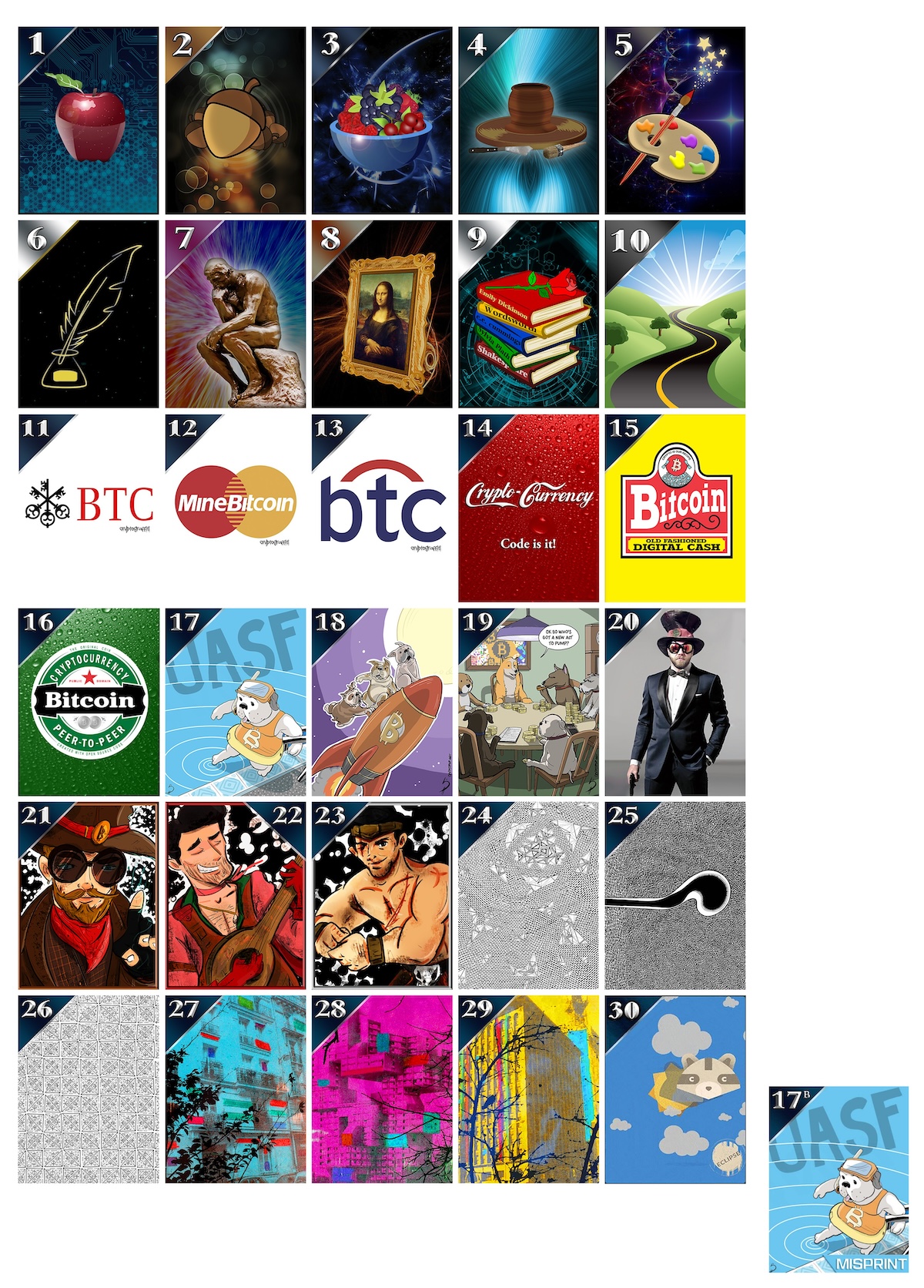For those interested in the early days of crypto art, there’s no ignoring Curio Cards.
Launched in May 2017 as a digital art show, the collection is widely recognized as the first art NFTs to be minted on Ethereum — predating CryptoPunks by six weeks. Aimed at using Ethereum to establish a new model for creating and distributing digital art, Curio Cards helped pave the way for the web3 art market as we know it. Consisting of 30 unique cards (31 if you count the misprint) by seven total artists, Curio Cards originally sold between $0.50 and $1, with 100% of sales revenue notably going to the artists.
Boasting a rich and eclectic history, Curio Cards have become a favorite of collectors due to their affordable entry point and trailblazing importance. Directly referenced in both EIP-721 and EIP-1155, which established the foundational standards upon which the modern NFT ecosystem is built, the Curio Cards smart contract was also the first to use IPFS to store its artwork — pioneering a practice that has become common for many NFTs today.
Historical NFTs experienced two considerable market run-ups last cycle in both August 2021, when CryptoPunks had its first major leg up to a six-figure price floor, and January 2022, when the rediscovery of CryptoSkulls led to heightened attention (and speculation) on early digital assets. Curio Cards were one of the primary projects to benefit from that meta in both market booms, hitting all-time highs across the collection in August 2021, with the rarest cards fetching more than 100 ETH each.
In October 2021, a full set of Curio Cards sold at Christie’s for 393 ETH ($1.267 million), helping cement the collection’s legacy with a landmark institutional sale that marked the auction house’s first ETH-denominated auction. Prominently featured in Taschen’s recently-released “On NFTs” art historical study with a two-page spread, the project is well-positioned to remain part of the early NFT canon as awareness and interest grow.
Will we see another historical NFT boom in the current cycle? History tends to repeat itself. While it’s true that many new entrants to the market tend to focus on new projects and short-term opportunities, the dominance of historically important projects like CryptoPunks will continue to drive enthusiasts down the rabbit hole of early NFTs.
That’s the beauty of the blockchain — its timeline is preserved immutably and publicly for future generations to discover. Much like CryptoPunks, Curio Cards carry practically no execution risk — no hype to create or airdrops to deliver, all they need to do is age gracefully and create awareness and acquisitions among notable institutions and collectors. While Curio Cards may not have the backing of a conglomerate like Yuga Labs to champion them, they do boast a dedicated collector base that includes notable names like 6529, Gary Vaynerchuk, DCLBlogger, Moderats, FaZe Banks, and more.
Please note that Curio Cards predate the modern NFT standards and must be wrapped in order to trade on marketplaces like OpenSea. Be sure to refer to the original website for total supply counts, as not all tokens have been wrapped for trading. As with most early assets, there is presumably a significant amount of Curio Cards lost forever on inactive wallets (the project website estimates 4,000 tokens). However, by cross-referencing the original supply size with the current active supply in marketplaces, you can get a sense of each card’s relative rarity. The most common cards currently trade for around 0.09 ETH ($366), while the rarer ones most recently changed hands between 5 and 10 ETH.
For this week’s edition of “Bargain vs. Bluechip,” I will examine some of the best-known and rarest Curio Cards through an investment lens. As always, this is not financial advice — simply an analysis of notable assets and the opportunities they may present!
Bargain: “Apples” Curio Card (#1)

The Token: “Apples” Curio Card (#1)
Floor Price: 1.1877 ETH ($4,538)
The Case for Bargain:
Created by phneep, the first 10 cards in the Curio Cards collection are the best-known among collectors. According to the Curio Cards metadata and website, “The first 10 cards exist as a collection, and tell a story that has since been forgotten, unless you can track it down.”
Long considered a vital inclusion in any serious historical NFT collection, the “Apples” Curio Card is emblematic of the project and benefits from several compelling narratives. As the first card in the series, it enjoys the provenance of being the genesis and the enviable claim to being the first art NFT ever minted on Ethereum.
“As the first card in the series, it enjoys the provenance of being the genesis and the enviable claim to being the first art NFT ever minted on Ethereum.”
As far as supply size goes, the “Apples” card is situated in a bit of a sweet spot with 2,154 total tokens (1,014 active) — not too common to tarnish its allure while not too scarce to impede consistent liquidity. Even during the depths of the bear market, the card continued to draw daily offers and maintain a floor price above 1 ETH.
Given its provenance and the premium that collectors put on being first to anything, the “Apples” Curio Card is a good bet to outperform others in the series over a long-term time horizon. During the previous historical NFT booms, “Apples” sold for an all-time high of 23 ETH in August 2021 and topped around 7 ETH in January 2022. Currently hovering around an all-time low in ETH terms, with offers below 1 ETH being accepted, the card is worth a look from aficionados and hobbyists alike due to the likelihood of significant gains in the next historical NFT boom.
Blue-Chip: “Complexity,” “Passion,” and “Education” Curio Cards (#24, #25, #26)

The Tokens: “Complexity,” “Passion,” and “Education” Curio Cards (#24, #25, #26)
Floor: 160 ETH ($643,712), 160 ETH, and 5 ETH ($20,117)
The Case for Bluechip:
Given their scarcity, the rarest Curio Cards do not change hands often and should be viewed comparably to a 1/1 artwork in investment terms — highly illiquid with potentially exponential upside. While the collection has a number of scarce cards to choose from, we’re going to focus on a trio of cards created by Daniel Friedman that occupy particularly rarified air.
Despite boasting the highest floors, “Complexity” and “Passion” are not technically the rarest Curio Cards in terms of original supply size (222 total tokens each). That distinction belongs to the third card in the series, “Education” (111 total tokens). However, while “Education” currently has 104 of those tokens in active supply, “Complexity” and “Passion” both only have 33 active — the lowest across the collection. As they say, the market never lies, and “Complexity” and “Passion” both have higher current offers and recent sales than “Education.”
“Given their scarcity, the rarest Curio Cards do not change hands often and should be viewed comparably to a 1/1 artwork in investment terms — highly illiquid with potentially exponential upside.”
Don’t let the current 160 ETH floor prices for “Complexity” and “Passion” scare you away — each card has only one listing from the same wallet at that ambitious price point. The highest offer on each card is currently 3.28 ETH, with “Complexity” most recently selling for 10 ETH last June, “Passion” selling for 7.5 ETH in December, and “Education” selling for 4.45 ETH in November. During the height of the historical NFT boom in August 2021, “Education” sold for a high of 125 ETH, “Complexity” sold for a high of 100 ETH, and “Passion” sold for a high of 82 ETH.
Most importantly, these cards’ rarity essentially set the current cap on possible complete sets at 33. As the recent $14.5 million Autoglyphs set sale demonstrated, serious collectors are willing to pay a premium for a complete set when the narrative is compelling enough. An investment in these cards is essentially a long-term bet on the continued recognition of Curio Cards’ historical importance and cultural legacy. If that thesis holds, there will be more suitors for a complete set of Curio Cards down the road, and the rarest ones will command considerably higher prices. Other rare cards to note include the trio created by Robek World and numbered from #21 to #23, consisting of “The Bard” (35 active supply), “The Barbarian” (42 active supply), and “The Wizard” (50 active supply).
Bottomline
Given their historical significance and wide range in rarities and price tiers, Curio Cards are a compelling project for collectors looking to add exposure to historical NFTs to their portfolio. Their provenance, combined with the fact that they were launched without a profit-making motive other than getting artists paid, is poised to age well.
As the genesis artwork in the series, “Apples” will almost certainly trade at higher ETH prices in the future. With traders currently chasing liquidity as ETH’s price rises, there are good buying opportunities available for those who can afford to take on a long-term hold.
For particularly patient and deep-pocketed collectors, putting in low-ball offers on “Complexity,” “Passion,” “Education,” and the other rare cards could pay off handsomely when the historical NFT meta returns in the future.
While Curio Cards don’t enjoy the same visibility as early PFP projects like CryptoPunks, appreciation for the project’s role in the annals of onchain art will only continue to grow in time. For those who can afford to lock them in the vault for years to come, the returns are likely to eventually be worth the wait.
Editor’s note: At the time of publication, the author holds 12 total Curio Cards, including one “Apples” card. He does not hold “Complexity,” “Passion,” “Education”, “The Bard,” “The Barbarian,” or “The Wizard” cards.
The post Bargain vs. Blue-Chip: Exploring the Rarest and Most Popular Curio Cards appeared first on nft now.








Leave a Reply